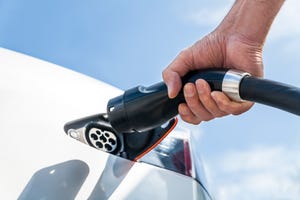If you’ve spent any amount of time weighing the pros and cons of electric cars, you’ve no doubt noticed that their sticker prices tend to be higher than their combustion-powered counterparts. Look beyond the point of purchase, however, and an EV’s reduced operating costs could end up saving you money over the long term.
But how long of a term are we talking? How long does it take to break even on an electric car? The answer is, perhaps unsatisfyingly, “it depends.” It depends on the class of vehicle you’re comparing, how much you drive and a variety of other factors. This guide will help you learn how to estimate for yourself and provide a few examples.
EV premium, tax credits
The first thing to calculate is the price premium an electric car commands over a gas-powered (or hybrid) alternative. You’ll be subtracting any long-term savings from this number later. If that EV premium pill is too tough to swallow, you could also consider shopping for a used example to minimize the initial cost — especially if you’re shopping for a second car or your range needs are on the more conservative side.
Also consider whether the EV qualifies for any state or federal tax credits that can give you a nice jumpstart towards that break-even point. The roster of qualifying EVs got quite a bit shorter when new battery regulations were announced earlier this year, but many familiar favorites are already returning to the list.
Read: 33 States Charge Electric Vehicle Drivers for Not Pumping Gas
Estimating basic operating costs
Now comes the tricky part: figuring out and comparing operating costs. This will come down to a number of factors, including the efficiency of the vehicles in question, the gasoline and electricity prices in your region, how many miles you drive per year and your driving habits. Here in the US, a great resource to get you in the ballpark is fueleconomy.gov, the Environmental Protection Agency’s official database of efficiency estimates.
Enlarge Image
Here, you’ll be able to search and compare the range, fuel efficiency and estimated fuel cost per year for almost any car sold in America dating as far back as 1984. The EPA assumes a 55% stop-and-go driving mix, 15,000 annual miles and the current fuel prices to calculate its fuel cost estimate, but you can (and should) personalize the formula with your own prices and mileage.
Armed with the EPA’s estimates, divide the EV’s price premium by the annual energy cost savings to come to the most basic estimate, in years, until your electric car would break even.
For example…
Let’s compare, for example, the 2023 Chevrolet Bolt EUV ($28,795) with the similarly sized Chevrolet Trailblazer ($23,395) and we find the EV is $5,400 more expensive at the outset. The EPA estimates that Bolt owners will spend $1,200 less charging every year versus gas based on average fuel and electricity at the time of publication. That works out to 4.5 years until the break-even point. However, the Bolt also qualifies for a $7,500 federal tax credit which, once claimed, works out to a savings of $8,100 over the first five years.
Tesla’s Model 3 and Model Y have also recently undergone multiple aggressive price cuts which, when combined with their newly reinstated federal tax credit qualification, means they could break even within the first year, if you’re cross-shopping against competitors from premium or luxury brands.
Enlarge Image
Without the federal incentive, however, it can be significantly longer before reduced cost makes up for the battery premium. The 2023 Hyundai Kona Electric, for example, is $11,410 more expensive than the contemporary gasoline-powered Kona. With an expected $1,050 in energy savings per year, but no tax credit, the EV driver would expect to break even in just under 11 years unless other variables, such as higher than average gas prices, dealer incentives or qualifying for state-level tax credits, come into play.
Other things to consider
There’s more to owning a car than how much you spend on gas or electrons. If you plan on installing a home charger, you’ll want to account for that in your estimates. Electric vehicles, without oil to change or complex emissions systems to break, often have significantly lower recurring maintenance costs than combustion cars. However, due to the newness and scarcity of specialized parts, when things do go wrong, unexpected EV repairs can end up being more expensive. That can feed into higher insurance premiums for electric cars, as well.
Read: The Total Cost of Owning an Electric Car Is Its Secret Weapon
Enlarge Image
Finally, consider whether you need a new car in the first place. If your current vehicle is in good working order and gets decent fuel economy, sticking with it for a few more years until EV costs come down may be the more frugal choice — especially if buying a new car would strain your budget. The most cost-effective car is often one that’s already paid for.

